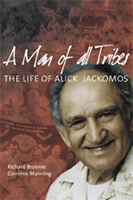A Man of All Tribes: The life of Alick Jackomos
Summary
Alick Jackomos was the son of Greek migrant parents, born in Collingwood, who grew up during the Great Depression. His is a remarkable life that recaptures stories of diverse communities and ways of life now vanished from sight.
From an adventurous boyhood growing up Greek in Melbourne, Jackomos survived war service, and became a travelling tent wrestler with Jimmy Sharman, whose boxing troupe was known Australia-wide. These shows relied heavily on Aboriginal boxers and audiences, and Jackomos actively crossed cultural boundaries to associate with Aboriginal people when most of the population chose to shun them.
There are few stories concerning non-Aboriginal people who crossed over into the Aboriginal world as did Alick Jackomos. He became Doug Nicholls’ apprentice in Aboriginal welfare work and activism for Aboriginal rights. His life is set in the context of evolving Aboriginal activism, yet there were moments of controversy as he was a non-Aboriginal man, with an Aboriginal family, living and moving in an Aboriginal world and working for Aboriginal causes.
All the while this man of little education collected a huge and remarkable photographic archive of Aboriginal Victorians and compiled over a thousand intricate genealogies.
Alick Jackomos was universally acknowledged as a person of rare humanity.
Reviews and endorsements
'In a fine passage Broome and Manning write that for Alick life ‘was a journey to oneness’... A Man of All Tribes is a timely production that provides us with more generous perspectives for thinking about the nature of identity and what it means to be Australian.'
— Philip J Morrissey, Australian Journal of Indigenous Education, December 2006
'Alick Jackomos’ legacy is a profound one and people with an interest in 20th-century Victorian community political history will welcome the publication of this biography.'
— Ian Clark, Aboriginal History, Vol. 32, 2008
